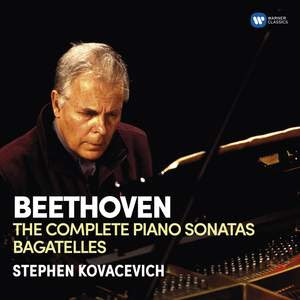Beethoven: The Complete Works (80 CD). Warner Classics / © 2019 Parlophone Records Limited. Also available on Spotify etc. I bought my box set from Fuga at Helsinki Music Centre.
Ludwig van Beethoven 1770–1827.
Beethoven 250 / corona lockdown listening.
From: CD 21/80 Piano Sonatas Nos. 16–20
Stephen Kovacevich, 1994 (Nos. 16–18) and 1999 (Nos. 19–20)
Opus 31 Nr. 3: Klaviersonate Nr. 18 in Es-Dur „La Chasse“ (1802)
Erster Satz: Allegro
Zweiter Satz: Scherzo. Allegretto vivace
Dritter Satz: Menuetto. Moderato e grazioso.
Vierter Satz: Presto con fuoco
AA: The piano is a string instrument, a keyboard instrument and a percussion instrument, and during Beethoven's lifetime it was evolving from the fortepiano (Hammerklavier) to the pianoforte. Beethoven's early works were written for the fortepiano and his late works for the pianoforte that was in progress of being developed towards the modern grand concert piano.
Probably compositions such as those by Haydn and Beethoven in the first decade of the 19th century inspired, encouraged and accelerated the development at piano factories such as Broadwood.
Beethoven's piano sonata Opus 31 Number 3 in E-flat major seems to celebrate the piano evolution itself and the piano's expanding expressive capabilities. Beethoven "plays the piano" in all senses: there is an extraordinary Spielfreude, joy of playing. It's a virtuoso piece in melody, harmony and rhythm. It's witty, spicy, inventive and surprising.
After the disturbing undercurrents of Piano Sonata No. 17 "The Tempest", this sonata is different in its tender and humoristic jocularity. It is a love letter in four movements. Perhaps a love letter to the piano. In his Guardian Lecture, András Schiff emphasizes the cantabile quality of the first movement and sings along: "Liebst Du mich?" ("Do you love me?"). An answer is not coming.
This sonata is Beethoven's last in four movements, and there is no slow movement, but instead both a scherzo and a menuetto in the middle. The menuetto is the profound movement, the one that inspired Saint-Saëns to compose a set of variations. It's also the movement in which a deep Beethovenian humanity is at its most compelling. Dark currents under the merry flow.
The last movement, Presto con fuoco, is the one that inspired Frenchmen to call this sonata "La Chasse" ("The Hunt", or, why not: "The Chase"), a title not approved by Beethoven, but it has stuck, and I find it apt. This hunt or chase is also playful. The focus is not on killing prey but the joy of the chase. One can imagine horses riding and hounds leaping merrily to and fro in the woods. In literature, I think about the hunting party in Leo Tolstoy's War and Peace that is essential in Natasha Rostova's Bildungsroman.
There has been a month's break in my blogging about Beethoven because there was so much to blog about Il Cinema Ritrovato in Bologna. I did not want to proceed in my listening programme before blogging, and as a result I have listened to this sonata for a month almost daily, in many interpretations, and all seem good.
But most of all I have been listening to Stephen Kovacevich who seems particularly inspired in the three sonatas of Opus 31. I never tired of listening to him.
BEYOND THE JUMP BREAK: ONLINE SOURCES:
The Beethoven Experience (BBC 2005)
https://www.bbc.co.uk/radio3/beethoven/index.shtml
Ludwig van Beethoven: Magnificent Master (2015)
https://web.archive.org/web/20151207110527fw_/http://www.raptusassociation.org/index.html
Beethoven's Piano Sonatas (2015)
https://web.archive.org/web/20150924084747/http://www.raptusassociation.org/sonindexe.html
http://digitalcollections.sjlibrary.org/cdm/search/searchterm/Portraits%20Beethoven%20Full%20figure/mode/exact/page/2
https://www.beethoven.de/en/archive/view/6559862288809984/Beethoven+playing
András Schiff's Guardian Lectures on Beethoven's piano sonatas
https://www.theguardian.com/music/classical/page/0,,1943867,00.html
Per Tengstrand
https://worldofbeethoven.com/overview-of-the-sonatas/
Bryce Morrison in Gramophone, February 2004
https://www.gramophone.co.uk/reviews/review?slug=beethoven-complete-piano-sonatas-10
Anthony Tommasini, The New York Times, 3 July 2020
https://www.nytimes.com/2020/07/03/arts/music/beethoven-piano-sonatas.html?action=click&module=Well&pgtype=Homepage§ion=Music
Belcanto.ru: Beethoven
https://www.belcanto.ru/beethoven.html

No comments:
Post a Comment